To the Editor: Drug-induced hypothyroidism has been well established in the literature with drugs like lithium, iodine, and amiodarone. We report a rare case of subclinical hypothyroidism in a patient on long-term valproate therapy.
A 30-year-old patient undergoing treatment for manic-depressive bipolar disorder presented with complaints of increasing fatigue and weakness. He was on sodium valproate and olanzapine therapy for 8 years before his clinical presentation. His laboratory findings revealed a raised thyrotropin (TSH) of 27.61 microIU/ml (normal range=4–7 microIU/ml) with normal T3 and T4, on two consecutive occasions. His liver function tests showed a raised SGPT (60U/liter). His renal function tests and basic hematological parameters were within normal limits. Subsequent tests for antithyroid antibodies were negative. There was no past history or family history of any thyroid disease.
Subclinical hypothyroidism is manifested by raised TSH with normal T3 and T4 levels. The prevalence of subclinical hypothyroidism is approximately 14% and is more frequently observed in females.
1 The main causes of hypothyroidism are autoimmune disorders, inflammation, iodine deficiency, drugs, radio ablated thyroid gland, post surgical resection, and pituitary disorders. Patients with subclinical hypothyroidism may occasionally present with signs and symptoms of clinically apparent hypothyroidism, such as fatigue, weight gain, and dry skin.
The association of hypothyroidism with drugs like lithium, amiodarone, and iodine is well established in the literature. Antiepileptic drugs, however, have been recently added to the list. Sodium valproate is commonly used in the treatment of epilepsy and bipolar disorder. It acts by destroying γ-aminobutyric acid (GABA) antagonist thereby increasing the levels of GABA, which is said to have an antimanic effect. The well-known side effects of valproate therapy are weight gain, dyspepsia, headache, and hepatotoxicity.
Studies in children undergoing long-term valproate therapy have shown a significantly higher level of TSH compared to controls.
2 Higher levels of TSH, with normal T3 and T4, were also seen in girls undergoing valproate monotherapy.
3 Contradictory to this, some reports suggest that though antiepileptic drugs like carbamazepine and phenytoin have been found to induce hypothyroidism—due to their hepatic enzyme induction properties which lead to increased clearance of thyroid hormones—valproate did not seem to have the same effect on thyroid function as it was not a hepatic enzyme inducer.
4As our patient presented with excessive fatigue, we evaluated his thyroid function tests, which revealed a subclinical hypothyroid state. Increased SGPT levels noted in the patient may be due to hepatotoxic potential of valproate. The patient had no history of radioiodine therapy or any surgical procedure which might have accounted for this clinical state. The patient had negative antithyroid antibody screens ruling out autoimmune causes. As there was no evidence in the literature to support the role of olanzapine in induction of hypothyroidism, we attribute the hypothyroid state of our patient to long-term valproate therapy.
This case report highlights the importance of routine thyroid function tests in patients undergoing long-term valproate therapy, which may lead to early detection of subclinical hypothyroid state and thereby prevent subsequent complications.

